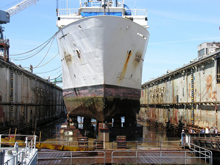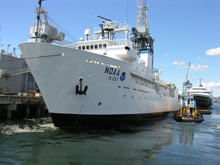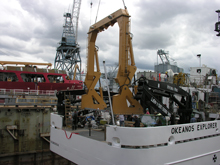
The former Naval surveillance ship Capable takes on a new role as the NOAA ship Okeanos Explorer. The vessel is shown here under repair and refit in dry dock in Seattle, Washington. Click image for larger view and image credit.
Test Driving the Okeanos Explorer
Craig W. Russell
ERT, Inc./NOAA Office of Ocean Exploration
Do you know anyone who recently bought a car? Chances are you do. Most likely, your acquaintance gave the car a good looking-over — checked under the hood, turned on the lights, took it out for a test drive, and had an independent auto mechanic inspect it for structural or mechanical problems as well as to ensure it met regulatory requirements, such as emissions and safety laws. If they were really serious buyers, perhaps they even read the owner’s manual to be sure they understood everything about the care (how to lock the doors, what pressure to fill the tires, etc.) before driving off.
As with any major purchase, it is important to ensure the work or product you paid for is actually delivered as promised and meets your expectations. You wouldn’t buy or accept a car with only two tires, would you? (That would be a motorcycle!) For this same reason, we will undertake a series of tests and trials to ensure the conversion, or refit work, that was done on the NOAA ship Okeanos Explorer is delivered as promised and meets our expectations. We will kick the tires, so to speak. Well, not exactly . . . but tires aside, the car metaphor help explain our goals in testing the Okeanos Explorer during this expedition.
Let us suppose there are a few basic rules that every designer follows in designing a car. For example:
- A car must roll
- A car must stop
- A car must not fall apart
- A car must perform its function(s) well
To test the basic four design rules of a car you might: take the car for a test drive to ensure the engine worked (a car must roll), ensure that the brakes worked (it must stop), go over some bumps and take some tight turns (it must not fall apart), and carry people and "stuff" safely (it must perform its functions well).
Since a ship is clearly different from a car, there are a few differences in function and design. In ship design, the four basic rules are:
- A ship must float
- A ship must float upright
- A ship must not break in half
- A ship must perform its function(s) well
These major differences between a ship and a car design require us to take a different approach to testing the ship before we accept it from the shipyard as complete.

The freshly painted Okeanos Explorer being tied up after leaving dry dock. The ship received new stern and bow thrusters, and handling, navigation, and safety equipment in dry dock. Click image for larger view and image credit.
We already know that the ship floats and it floats upright because it is currently tied up to a pier in Seattle. But, how well it floats upright is another story. Here’s why: during the refit process, lots of old equipment and steel was removed from the ship, and new equipment was loaded in different places. This makes the weight distribution different from when it was originally designed and last sailed on a voyage. Using mathematical models, engineers calculated the stability of the ship and have confidence the ship will float upright. But when you ask them how well the ship will ride, they are the first to tell you, “We’ll see.” So, testing the ship’s stability (how well it floats upright in different sea and weather conditions) is an important test. In a future log, we’ll report out on the progress of stability testing.
Will the ship break in half? That is very unlikely. While a lot of structurally important steel was removed, reinforcement was added to ensure it met current industry standards. The ship was built in the 1980s, when regulations and standards were different than they are now, so quite a bit of work was done to ensure it meets the letter of the law today, in 2007. We do not expect to be reporting out on this item, but if we do, you can be sure it only means one thing — that the ship broke in two — and that will make for some very interesting reading.
Perhaps the most complex testing involved will be to see if the ship performs its functions well. So what are these “functions”? Before the first torch was set to the ship to remove steel, a group of scientists, explorers, and engineers met to decide the key functions of the ship.
First, they determined the ship should be able to map the ocean bottom in very deep water, down to 6,000 meters (19,685 feet or 3.73 miles) depth. The second function they agreed to was to provide a platform and “mothership” for remotely operated vehicle (ROV) operations. Third, they decided the ship would provide real-time video, audio, and data from the ship to shore-based explorers via what is known as "telepresence." Finally, the most important function of any ship is to serve as a floating home for its crew members and explorers — in this case 46 people.
In order to conduct deep-sea mapping, we purchased and had installed a new multibeam mapping system. During sea trials we will conduct preliminary tests of this system and report on how well it is working. We expect there will be some changes made to the system later this year, but the basic functionality of the system will still be tested.
For the vessel to be an ROV operations platform, it needed a lot of changes and new equipment, such as cranes, winches, working spaces, and propulsion systems, to name just a few. Although we do not yet have an ROV to test all of this completely, we will be testing the basic functionality of each of these systems during sea trials.
We will be installing telepresence over the next six months (during a second shipyard period), so we won’t be testing that quite yet.

The new A-frame, shown here as it's being landed on the aft working deck of the Okeanos Explorer, is a critical piece of handling equipment. The ROV will be connected to the ship through the A-frame. Click image for larger view and image credit.
Finally, we will be testing everything that makes Okeanos Explorer a floating home for the crew members and explorers. Think about the things in your home that you depend on each day. All of these things are also on a ship: clean water to drink, cook, and bathe with; air conditioning and heating; a stove and oven to cook; someplace to eat your meals; a place to have fun and be entertained; and, most importantly ,a comfortable place to sleep, especially after a long hard day at sea.
During the conversion, we upgraded the galley (kitchen) with new appliances, installed new tables, seats and serving equipment in the mess deck (dining room), refurbished the heating ventilation and air conditioning (HVAC) system, and corrected many other things that needed replacement, repair or refurbishment. (We will be doing more of these upgrades later this year.) On this cruise, we will test most of these systems to ensure they will make the Okeanos Explorer a comfortable home for 46 people as they sail the globe, exploring the vast ocean.
Keep checking back for updates this month. Read about how the sea trials are going, and see photos and video clips of trials in action. Until then, consider checking your car's tire pressure, brakes, and fluid levels. Give the engine a wipe down, and take it for a test spin to listen real closely how well it performs. That’s what we’ll be doing with the Okeanos Explorer.





